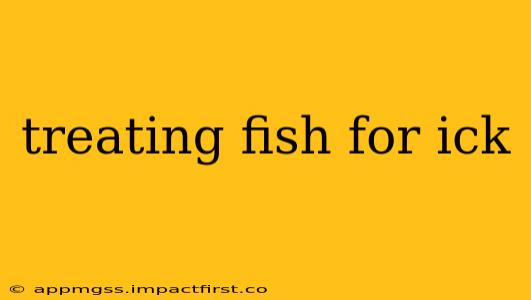Ich, also known as Ichthyophthirius multifiliis or white spot disease, is a common and highly contagious parasitic infection affecting freshwater fish. Characterized by tiny white spots on the fish's body, fins, and gills, Ich can quickly become fatal if left untreated. This comprehensive guide will cover various aspects of treating fish for Ich, helping you effectively manage this challenging ailment.
What is Ich?
Ich is a protozoan parasite that attaches itself to the fish's skin and gills. It feeds on the fish's tissues, causing irritation, stress, and ultimately, death. The white spots you see are actually the parasite's cysts, which contain hundreds of infective tomites. These tomites are released when the cyst ruptures, infecting other fish or the aquarium environment. The life cycle of Ich involves several stages, making eradication challenging. Understanding this lifecycle is key to effective treatment.
How to Identify Ich in Your Fish?
Identifying Ich requires a keen eye. Look for the telltale tiny white spots, which may resemble grains of salt scattered across the fish's body. These spots are often most noticeable along the fins, gills, and flanks. Infected fish might also exhibit:
- Flashing behavior: Fish frantically rubbing themselves against objects in the tank.
- Lethargy: Loss of appetite, reduced activity, and listlessness.
- Clamped fins: Fins held close to the body.
- Respiratory distress: Difficulty breathing, rapid gill movements.
- Loss of color: Fading or dulling of the fish's natural coloration.
What are the Common Treatments for Ich?
Several effective treatments are available for Ich, each with its own strengths and weaknesses. Choosing the right treatment depends on the severity of the infection, the type of fish affected, and your aquarium setup.
1. Raising the Temperature:
Increasing the aquarium water temperature slightly can speed up the Ich life cycle, making it easier to eradicate. Aim for a temperature increase of 2-3°F (1-2°C) above the fish's normal tolerance. However, always check your fish species' temperature tolerance before doing this to prevent thermal stress.
2. Medication:
Various medications are effective against Ich, including:
- Malachite green: A classic treatment known for its effectiveness but can be toxic to invertebrates and some sensitive fish species.
- Formalin: Another widely used treatment but needs careful dosage to avoid harming fish.
- Copper-based medications: Copper is effective against Ich but can be toxic to invertebrates and plants. Always follow the instructions carefully.
- Acriflavine: A less toxic option than malachite green, but may not be effective against all stages of Ich.
Important Note: Always follow the manufacturer's instructions carefully when using any medication. Overdosing can harm or kill your fish.
3. Aquarium Salt:
Adding aquarium salt to the water can help create a hostile environment for Ich, and may support the fish’s immune response. However, use it cautiously, as it can harm some invertebrates and sensitive fish species. Start with a low concentration and gradually increase it as needed.
How to Prevent Ich in the Future?
Prevention is always better than cure. Here are some tips to minimize the risk of Ich outbreaks:
- Quarantine new fish: Before introducing new fish to your main aquarium, quarantine them in a separate tank for at least two weeks to observe for any signs of illness.
- Maintain good water quality: Regular water changes, proper filtration, and avoiding overfeeding help prevent stress, which can make fish more susceptible to disease.
- Avoid overcrowding: Overcrowded tanks increase the risk of disease transmission.
What is the Life Cycle of Ich?
Ich has a complex life cycle, crucial to understand for effective treatment. It involves the following stages:
- Theront: The free-swimming, infective stage that searches for a host fish.
- Trophont: The parasitic stage where the Ich attaches to the fish and feeds. This is when you see the characteristic white spots.
- Tomont: The reproductive stage where the Ich divides asexually, producing thousands of infective theronts.
How Long Does it Take to Treat Ich?
The treatment duration varies depending on the severity of the infection and the chosen method. It typically takes several weeks to completely eradicate Ich, even with treatment. Be patient and persistent, and continue monitoring your fish closely after treatment is completed.
Can Ich Spread to Other Fish?
Yes, Ich is highly contagious and can spread rapidly amongst fish in the same aquarium. Close monitoring and prompt treatment are crucial to prevent a widespread outbreak.
This guide provides a comprehensive overview of treating Ich in fish. Remember that early detection and appropriate treatment are crucial for a successful outcome. If you are unsure about any aspect of treating your fish for Ich, consult a veterinarian specializing in aquatic animals for personalized advice. Their expertise can provide tailored solutions for your specific situation and ensure the health and well-being of your fish.
